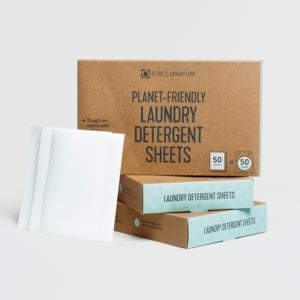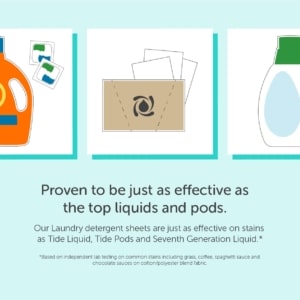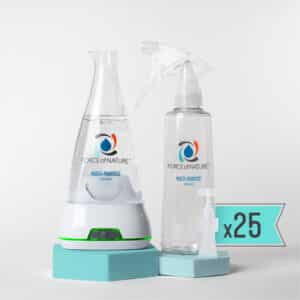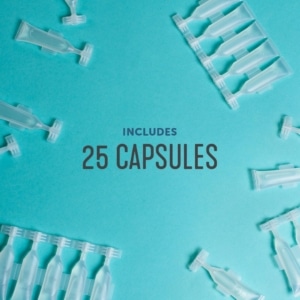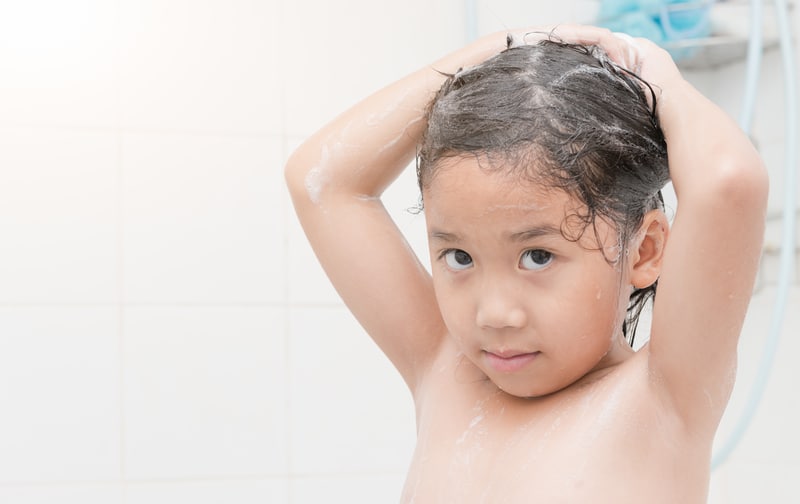
If you’re like most people, you decide which shampoo to buy based on how it smells or whether your hair is fine, curly, color-treated or just naturally perfect (we won’t hold that gift against you). If you have kids, you probably look for shampoos with the fragrances they like (bubblegum, anyone?). But what if we told you that many of the most common ingredients, even in shampoos labeled as “natural”, were never required to be tested for safety and are highly toxic? As in absorbed through the skin, carcinogenic, endocrine-disrupting kind of toxic. But we’re not here to scare, we’re here to help with your checklist of ingredients to avoid as you make the switch to a more toxic chemical free shampoo.
How to Choose a Chemical Free Shampoo: The Top 8 Ingredients to Avoid
1. Sodium laureth sulfate (SLES) & Sodium lauryl sulfate (SLS)– These are surfactants and emulsifying agents that help create suds and are very common in shampoos. SLES is associated with organ system toxicity and skin, eye, or lung irritation. Another major concern is that often, when SLS or SLES are present in shampoos, the contaminant 1,4 dioxane is too. That’s because the manufacturing process for these sulfates results in their being contaminated with this carcinogenic by-product. To avoid these, look for shampoos that say “sulfate free” and confirm they are not listed on the ingredient label.
2. Parabens – Parabens are commonly used as preservatives in personal care products like shampoo. They prevent the growth of bacteria and other microbes which is great, except that scientists have found trace amounts of parabens in malignant tumors. Parabens can cause endocrine disruption, reproductive toxicity, developmental toxicity, and cancer. To avoid parabens, skip shampoos with ingredient names that contain the word “paraben”. Examples include: methyl paraben, propylparaben, ethylparaben, and butylparaben.
3. Fragrances – We know the fragrances in shampoos are great for making you feel clean, refreshed, awake, ready for the day, etc. But before you decide that you can’t live without your favorite shampoo and its delightful smell, there are some things you should know about fragrances:
- They aren’t actually making your hair more clean – they are just giving you that perception.
- Fragrance chemicals can pass through the skin and into the blood.
- Many of the chemicals used to make fragrances are classified as allergens, hormone disruptors, and asthma triggers. Others are classified as carcinogens or neurotoxins.
- The fragrance industry regulates itself, so the ingredients in fragrances aren’t listed because they are considered “trade secrets” and aren’t required to be safety tested.
- Often only one word, “fragrance”, is used on the label and can hide more than 100 potentially toxic ingredients.
- So called “natural fragrances” can be just as toxic as synthetic fragrances.
- Most fragrances contain phthalates (# 7 below).
To avoid fragrances, the Environmental Working Group advises that consumers read the word “fragrance” or “parfum” and translate it to mean “hidden chemicals”. Always choose fragrance-free shampoos. Also don’t be fooled by shampoos labeled with “natural fragrance,” because there is no standard criteria for what these words mean.
4. Phthalates – Phthalates are commonly used in fragranced products including shampoos to help the scent linger longer. Health risks for phthalates are broad and significant including:
- Cancer – According to The National Toxicology Program, phthalates are “reasonably anticipated to be a human carcinogen”.
- Human reproductive and developmental risks
- Endocrine disruption
- Birth defects
- Respiratory problems
To avoid phthalates, avoid all fragranced shampoos. This is probably the biggest step you can take towards a more toxic chemical free shampoo.
5. BHA/BHT – On a hazard scale of 1 to 10 at EWG, BHA ranks high at a 10, so skipping shampoos with this one is a big step in switching to a chemical free shampoo. Butylated hydroxyanisole (BHA) and butylated hydroxytoluene (BHT) are preservatives that are founds in a number of personal care products including shampoo. These chemicals accumulate in the body and can cause immunotoxicity, endocrine disruption, developmental toxicity, reproductive system toxicity, cancer, and organ system toxicity. To avoid these, skip shampoos with butylated hydroxyanisole (BHA) and butylated hydroxytoluene (BHT) listed on labels.
6. DEA/MEA/TEA (Ethanolamine Compounds) – Ethanolamine compounds are used in a variety of ways in shampoos. DEA is an emulsifier while TEA is used as an ingredient in fragrances to adjust the pH. Research on ethanolamines have linked this class of substances to liver tumors. The European Commission has banned DEA (diethanolamine) in cosmetic products. These ingredients accumulate in the body and can act as carcinogens, causing organ system toxicity, as well as environmental issues. To avoid these, skip any shampoo with TEA, DEA, MEA listed as part of the ingredient name, as well as those listing triethanolamine, diethanolamine, or monoethanolamine.
7. 1,4 Dioxane – 1,4 Dioxane is an ingredient in many personal care products such as shampoos, but you won’t see it listed on any ingredients label. Why? Because it’s a contaminant and an unwanted by-product of ethoxylation, a process that’s used to reduce the risk of skin irritation in products that contain petroleum-based ingredients. 1,4 Dioxane can cause skin, eye, or lung irritation, and organ system toxicity, birth defects and various forms of cancer. The prevalence of this toxic villain is certainly sufficient to make us switch to a chemical free shampoo! To avoid it, read labels to avoid chemicals that may signal the presence of 1,4-dioxane, like sodium laureth sulfate, sodium lauryl sulfate, PEG, “ceteareth”, and “oleth”.
8. Methylisothiazolinone (MIT) – This is a very common preservative in shampoos, including those claiming to be “natural”. MIT is associated with health risks including skin reactions (it is a contact allergen), skin sensitization, painful rashes, inhalation toxicity, organ toxicity, neurotoxicity (based on lab studies on the brand cells of mammals). To avoid it, skip any shampoos with these ingredients listed: methylisothiazolinone, 3(2H)-Isothiazolone, 2-methyl-, 2-Methyl-2H-isothiazol-3-one, 2-Methyl-4-isothiazolin-3-one, 2-Methyl-3(2H)-isothiazolone.
Learn More
Now that you have your handy checklist, make sure you skip any shampoos containing these 8 toxic villains. Finding a good chemical free alternative to the shampoo you’ve been using may seem difficult, but a great resource for researching ingredient and product safety is the EWG Skin Deep Cosmetics Database. Or you can simply help jumpstart your switch by skipping those fragrances.
